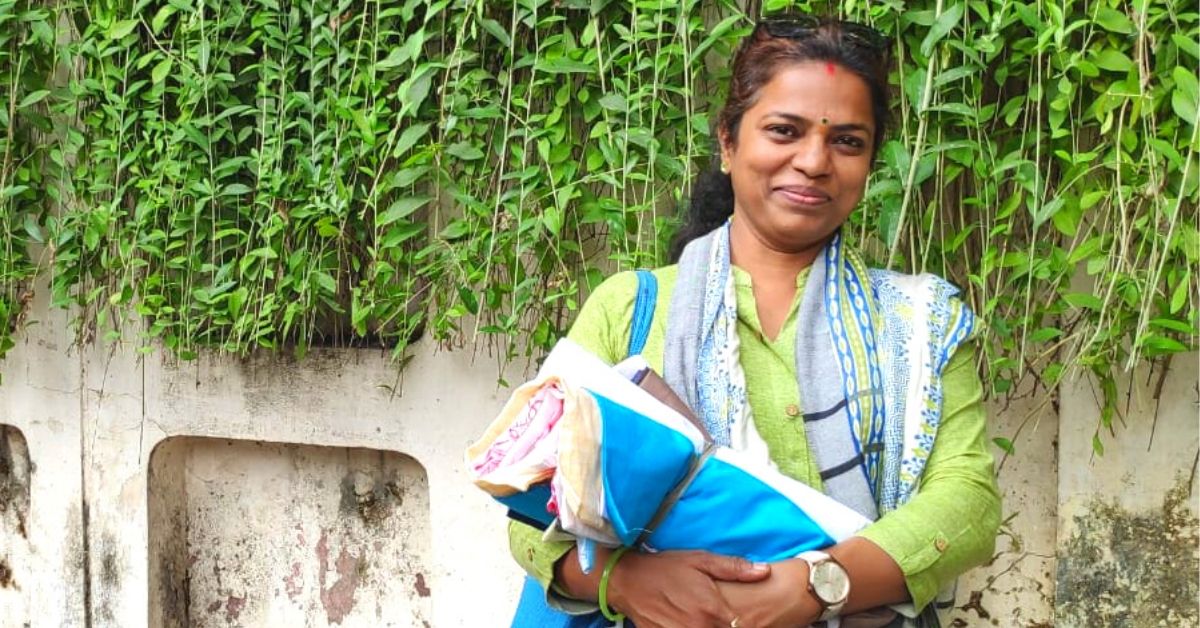Pamphlets to Fallen Hair: Nagpur Woman Treats 90% of Her Waste In Just 5 Steps

Managing her household waste is not a choice for Shefali Dudhbade but a way of life. The 46-year-old from Nagpur, a professional architect by profession and an environmentalist by heart, is setting an example for ordinary citizens who feel that municipal corporations are solely responsible for dealing with garbage.
“My kitchen waste, which accounts for 60% of my household waste, takes 15 minutes to treat,” Shefali tells The Better India, dissipating the time-consuming myth. Now, imagine if 50% of the country’s households devote a few minutes to composting on-site, India would significantly reduce its annual wet waste. Shefali credits her upbringing for her decisions in favour of the environment.

Shefali Dudhbade
“My grandfather would often get a litter from outside and out of paper or plastic make something useful. He always said if we are so aware of keeping our homes clean then why do we leave our surroundings dirty? The simple thought has made me a minimalist girl, “Shefali shares.
She is also a founding member of the Swachh Association, working with the Nagpur Municipal Corporation (NMC) to raise awareness about city waste management. She has treated 90 per cent of the waste for the last ten years, while only a fraction goes to the landfill.
Isn’t that breathtaking?
Shefali lists five troubleshooting steps to help you cut the waste.
1. Waste Segregation

Divide waste into five categories: a) Non-recyclables: Used paper towels, hazardous chemical or food containers, plastic products, and dishware are just a few examples of waste that can not be recycled or reused. Shefali hands over this form of waste to the NMC (which amounts to only eight per cent of its total waste).
B) Recyclables: PET bottles, plastic carrying bags, magazines, clothing, table cloth, glass, plastic cups are some items which can be stopped from being sent to landfill if properly separated. Shefali gives these to the city’s plastic recycling centres or creatively turns them into useful products such as pen stands, containers, plant pots, etc.
C) Wet: both kitchen and garden waste is composted by Shefali.
D) Sanitary: keeping the sanitary pads aside is the most important aspect of segregation, as it can discourage ragpickers or waste collectors from exposing themselves to health risks.
E) E-waste: Holds cardboard where all electronic waste such as batteries, remote controls and wires are stored. She sends them out to the local electronic waste collection centre once a year.
2. Reduce, Reuse, Recycle & Refuse

Jaadu ka Pitara’ (magic box), is how the friends of Shefali relate to the bag that she carries every time she steps out of her home. It contains a bottle of water, fabric or paper bags, paper straws and a box so she can reject something containing plastic.
“It’s not possible to eliminate plastic so the next best thing is to reject it. Start by carrying a cloth bag, as it takes up very little space in your bag. Be mindful of your schedule, and the locations that you visit regularly. Gradually form a jaadu ka pitara of your own, “she says.
As for recycling or reuse, she makes paper bags from magazines, pamphlets and distributes them to medical and general supply stores free of charge. Creating a paper-bag takes as little as five minutes.

She also gives paper cuttings to vegetable and flower vendors, “Now with the plastic ban, newspaper covers come handy for them.”
3. Composting

In her backyard, Shefali dug a small composting pit. Both kitchen and garden waste is first dried for 2-3 days on a newspaper, before being applied to the pit.
It takes nearly 45 days to convert organic waste, such as bulbs, seeds, fruit peels, vegetables, eggshells, coffee or tea powder into fresh organic compost, which is used in her terrace garden.
4. Medical Waste

Shefali and her daughter ensure they properly wrap their monthly sanitary waste in a newspaper before giving it to the waste collector. The most important step, she says, is putting a red dot on this medical waste. “Ragpickers or waste collectors rummage on landfills by waste, so they can make money by selling dry garbage. Many even go through the waste pile to find leftover food inside a newspaper, normally. They often open the newspaper to find a used sanitary pad with their bare hands and nothing can be more inhuman than this. It is our responsibility to ensure that they are not exposed to such waste by simply placing a red dot on the paper with a marker, “Shefali informs.
5. Fallen Hair

Have you ever come across or heard of someone who gathers and washes their own fallen hair?
Sounds bizarre, right?
Well, while sweeping, Shefali collects fallen hair, and stores it in a container. She washes it once or twice a month with shampoo and hands it to companies that deal with waste hair recycling.
Managing Your Own Waste Is A Matter of Pride
Degradation of the environment is inevitable with the depletion of our natural resources, the fuming of landfills and forest burning.
We may not be able, as individuals, to stop or reverse the impending crisis. Nevertheless, what we can do is to avoid further destruction of the environment, by reflecting on our actions.
Next, you can handle your own waste or cut down on garbage generation with people like Shefali proving it’s not a challenging job.









